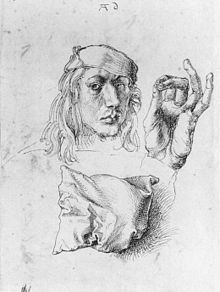Where Do Images Come From?
Excerpt from Toward a Philosophy of Perception
Based on The Dictionary of the History of Ideas: Chance Images
Leonardo, moreover, states more clearly than Alberti does that chance images are not objectively present but must be projected into the material by the artist’s imagination
– H. W. Janson In the Middle Ages a particularly strong example of chance images appears in a 1493 Albert Dürer drawing. The young artist’s self-portrait is on one side of the drawing with a pillow and a sketch of his left hand. On the other side, there are six more seemingly pointless pillows. Seeing no obvious artistic purpose, Heinz Ladendorf finally recognized that the folds held hidden faces—such as of a bearded Turk wearing a large turban. From upside down, they revealed more: a male, his craggy face topped by a pointed hat. The author of this Dictionary article, Janson, concludes that Dürer could not have known of a history of images in pillows, as none existed. He doubtless made the discovery accidentally. But the basis for it must have been his “familiarity with chance images in other, more traditional materials.”
As for Da Vinci: Leonardo recommends that painters look for landscapes and figures in the accidental patterns of stained walls, varicolored stones, clouds, mud, or similar things, which he compares to “the sound of bells, in whose pealing you can find every name and word you can imagine.” The spotted walls, clouds, etc., here obviously play the same role as the tree trunks and clumps of earth in [Alberti’s] De statua (Dictionary, p. 347). From earliest times, back to cave drawings, chance images were found in nature ready-made. But Dada and Surrealism “acclaimed chance as the basis of aesthetic experience. . . . What the Dadaists sought to elicit was not chance images so much as ‘chance meetings’—unexpected juxtapositions of objects which by their incongruity would have a liberating effect on the imagination” (p. 353). Going further, more recent artists tried to create such images. The Dictionary notes that the connection between chance and inspiration was so obvious to them that “[t]he sponge-throwing Protogenes, were his story better known today, would be the ideal hero of many mid-twentieth-century artists” (p. 353). In that story, as told in Pliny’s Natural History, a famous painting by Protogenes, called Ialysus, took seven years to complete. Frustrated at trying to evoke foam from dog’s mouth, he at one point finally threw his sponge at the panel. When it accidentally hit the dog’s mouth, it created the desired effect. The “wondrous” luck, Pliny attributed to fortuna.
The inference, . . . , it would seem, is that Fortune reserves such ‘strokes of luck’ only for the greatest of artists, as if on occasion she took pity on their ambition to achieve the impossible (p. 342).
Which begs the question of whether the cloud images are projected (at least, in part) by the imagination. Staring at the clouds seemed necessary to me. But in fact, what did that mean? And what role was played by light, the photon carriers of magnetism, acting as conduit, those miles to the eye?
